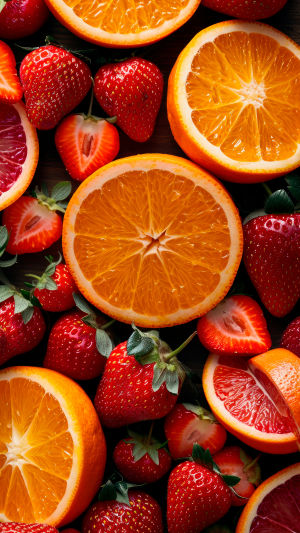Vitamin C, or ascorbic acid, is a vital nutrient known for its immune-boosting properties, antioxidant effects, and role in collagen synthesis. Including a variety of vitamin C-rich fruits in your diet can support overall health and well-being.
Dear Lykkers, here's a guide to some of the top fruits packed with vitamin C, their cost-effectiveness, and their global production hotspots.
<h3> Top Fruits Rich in Vitamin C </h3>
<b>1. Kakadu Plum </b> - At the pinnacle of vitamin C content, the Kakadu plum boasts a staggering 2,100 mg of vitamin C per 100 grams. This Australian native fruit, with its tart flavor, is renowned for its exceptionally high vitamin C concentration, far surpassing most other fruits.
<b>2. Acerola Cherry </b> - Another powerhouse, the acerola cherry contains about 1,600 mg of vitamin C per 100 grams. This fruit is native to the tropical regions of the Americas and is often used in supplements and juices due to its intense vitamin C content.
<b>3. Guava </b> - Guava is a tropical fruit with approximately 228 mg of vitamin C per 100 grams. It’s widely appreciated not just for its high vitamin C levels but also for its rich flavor and versatility in both savory and sweet dishes.
<b>4. Kiwi </b> - With around 93 mg of vitamin C per 100 grams, kiwi offers a substantial amount of this vital nutrient. Its unique taste and texture make it a popular choice in fruit salads and smoothies.
<b>5. Strawberries </b> - These beloved berries provide about 59 mg of vitamin C per 100 grams. They are widely available and are a favorite ingredient in desserts, jams, and salads.
<h3> Cost-Effectiveness and Pricing </h3>
In terms of cost-effectiveness, the availability and price of these fruits vary significantly across different regions.
• <b> Kakadu Plum </b> is quite expensive outside Australia due to its rarity and high demand in specialty markets. Its price can be prohibitive for regular consumption.
• <b> Acerola Cherry </b> is also relatively costly, especially when found in its fresh form. However, powdered and supplement forms can be more affordable and widely available.
• <b> Guava </b> tends to be reasonably priced, especially in tropical regions where it is grown. In non-tropical areas, it may be somewhat more expensive but still relatively affordable compared to the exotic fruits.
• <b> Kiwi </b> and <b> Strawberries </b> are generally more cost-effective and accessible in many countries. They are cultivated in various regions and are widely available in supermarkets, making them a budget-friendly choice for those looking to boost their vitamin C intake.
<h3> Global Production </h3>
• <b> Kakadu Plum </b> is predominantly produced in northern Australia. Its cultivation is concentrated in the wild regions of the Northern Territory.
• <b> Acerola Cherry </b> is primarily grown in tropical countries such as Brazil, Puerto Rico, and other Caribbean nations.
• <b> Guava </b> has a broad production range, with significant cultivation occurring in India, China, and tropical regions of South America.
• <b> Kiwi </b> is extensively produced in countries like Italy, New Zealand, and Greece, which have favorable climates for its growth.
• <b> Strawberries </b> are grown in many countries worldwide, with major production in the United States, Mexico, and Spain, among others.
Incorporating a variety of vitamin C-rich fruits into your diet can provide significant health benefits. While exotic fruits like Kakadu plums and acerola cherries offer impressive vitamin C content, more common fruits such as guavas, kiwis, and strawberries provide accessible and cost-effective alternatives.
The availability and pricing of these fruits can vary based on location and seasonal factors, so exploring local markets can also be a good strategy for obtaining these nutritious options.
Top 13 Richest Sources of Vitamin C (Boost Immune System)
Video by Respiratory Therapy Zone





